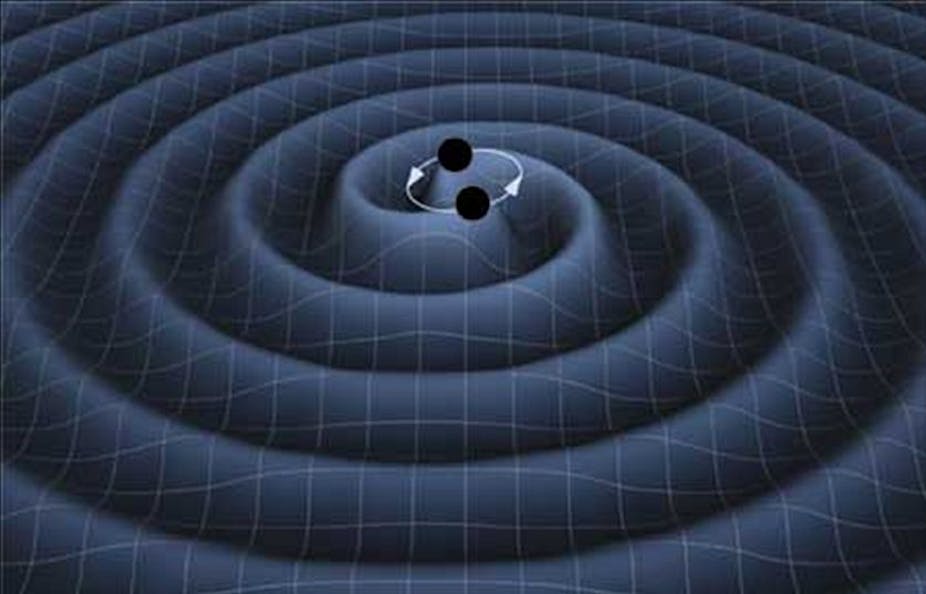Detecting gravity waves is a major goal for astrophysicists.
We know they should be there, but we haven’t found them yet. But today we are one step closer.
By literally squeezing light on a quantum level, we are refining our detection instruments to an extent never seen before.
I am part of the LIGO Scientific Collaboration that has performed the first large scale demonstration of an exquisitely elegant new measurement technique. The results are published in Nature Physics this week.
Remarkably, we have broken through the quantum measurement barrier that up to now set a limit to the sensitivity of our detectors.
This barrier is related to the famous Heisenberg uncertainty principle but in gravitational wave detectors is more easily understood as being due to the particle-like nature of photons.
Our demonstration proves that real gravity detectors can surpass this barrier, revealing new horizons for gravitational wave astronomy.
What came before
The search for the electromagnetic waves predicted by James Clerk Maxwell reached a climax when Heinrich Hertz succeeded in detecting waves transmitted across a table in 1886.
Hertz saw no benefits from his experiments, saying, “I am just trying to prove that Maestro Maxwell was correct.” Others quickly saw the possibilities and it was not long before we had the radio.
Today, thousands of physicists across the planet are trying to prove another maestro, Albert Einstein, was correct by building what you could think of as gravity radios.
These devices, officially known as gravitational wave detectors, are designed to allow us to tune into the gravity waves predicted by Einstein in 1916 as part of his theory of general relativity.
Vast amounts of gravitational wave energy is believed to be continually passing through the earth, and yet it remains undetected so far.
Our gravity receivers are based on laser technology. Gravitational waves are a bit like sounds that travel through empty space at the speed of light.
As with sounds, they make things vibrate, but they couple to matter so weakly that only the most exquisitely sensitive instruments can detect them.
Black holes and sensitivity
The birth of a black hole creates a tsunami of rippling space. More energy is given out than the sun emits in a billion years.
When two black holes coalesce, the burst of energy that travels out at the speed of light carries a power equal to that of more than a hundred-billion-trillion suns.
But so far we cannot detect even these enormous bursts because our sensitivity to the vibrations of the 40 kilogram mirrors of our detectors is still not high enough.
This weeks announcement heralds a breakthrough in our ability to measure the tiny vibrations of the detector’s mirrors.
Over the past two decades, gravitational wave detectors have been improved a million-fold, but they have always come up against the quantum measurement barrier.
Up to now the only way of reducing the uncertainty of our measurements has been to increase the number of photons by using enormously powerful laser light.
Great effort has gone into developing high-power laser detectors, and a new generation of these detectors is now under construction.
They are almost certain to detect gravity waves through the use of hundreds of watts of laser light, built up by resonance to almost a million watts inside the detector – we build up light in the detectors the same way you can build up a child’s swing with lots of small pushes.
But this is a brute force approach.
Our report shows that by squeezing light, we can get around the sensitivity problem in a much more elegant way.
The big squeeze
The quantum barrier arises because the invisible quantum fluctuations that appear to fill every point of empty space leak into the detectors at the point of measurement.
These fluctuations are invisible, but we realised they could be “squeezed”.
Squeezing is a method of changing the randomness of light, and is based on the weird phenomenon called quantum entanglement that Einstein dismissed as “spooky action at a distance”.
The technology used in this case was pioneered by the Centre for Gravitational Physics at ANU, refined by scientists at the Albert Einstein Institute in Germany, and tested on a detector called GEO600 in Hanover.
A device called a light squeezer that uses entangled photons is used to squeeze the ghostly quantum fluctuations where they enter the detector.
The method is the first demonstration of quantum entanglement being used to improve sensitive instruments.
Using squeezing, the team was able to measure vibrations 100,000 times smaller than the nucleus of a typical atom.
How ripples become waves
This result is just the start.
Gravity research is riding a wave of innovation. At our Gingin Gravity Centre we are researching other methods of creating quantum entanglement, as well as creating springs and rods made from pure light that enable gravitational wave detectors to extract more energy from passing waves.
The US, UK and Germany have offered Australia a $140 million detector called LIGO-Australia, proposed to be installed at the Gingin centre.
It’s designed to fill the need for a southern hemisphere detector that will allow much better triangulation of incoming waves, helping to turn all the detectors in the world into a single omnidirectional telescope able to monitor and pinpoint every black hole birth in the universe.
Not only will such findings make waves – they will also, with any luck, help scientists to discover some.

